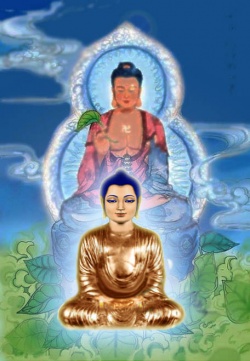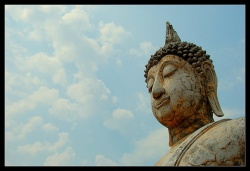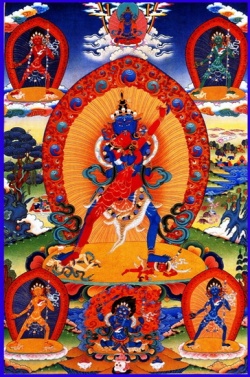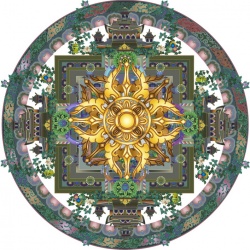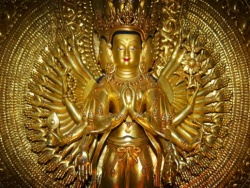Samsaric existence
In Buddism, there is the teaching of the six worlds, or the six realms of existence. The six worlds are often used to explain states of mind. Our states of mind, arising through ignorance and attachment, which people go through continuously.
The world of heaven. This is the world of enjoyment, pleasure or pleasant things. The condition of heaven is impermanent, and this state of mind will also change.
The world of humans. (Human beings) In the world of humans, sometimes we are happy, sometimes we are sad, sometimes we are laughing, sometimes we are crying.
The world of asuras. This is the world of fighting, or strife. The realm or state of mind of fighting.
The world of hungry spirits. This is the realm of dissatisfaction, not being content. The state of having endless unsatisfied desires, or greed. Figuratively speaking, always being hungry.
The world of animals. It is the realm lacking reason. The state without reason. Without reason, mistakes are made, causing hardships or suffering to self, and at times others. Without reason, being dominated by one's desires.
The world of hell. Hell refers to the realm of suffering. The state of suffering and pain, which through cause and condition people will enter.
These six worlds, or realms of existence represent the states of mind which human beings go through continuously. And outside of these six worlds, there are four other realms.
Sravaka (Shomon). This refers to a person who hears the teachings. A disciple. A person who hears the teachings, and puts the teachings into practice.
Pratyekabuddha (Engaku). This refers to people enlightened through causal condition. Enlightened by themselves.
Bodhisattva (Bosatsu). A being destined for enlightenment. This refers to people who practise the Way with a firm belief that they can see into their nature and attain enlightenment.
Buddha (Hotoke). The Buddha refers to someone who has seen into their nature, forgotten the ego/self.
In order that all beings may hear the Buddhist teachings and practise the Dharma, the successive Buddhas and Patriarchs have transmitted the Buddha Dharma through the ages to the present day. And due to their great compassion and constant practice, we are able to receive the benefits of the Buddhist teachings. Hearing the teachings, this is the meaning of 'Sravaka'.
Hearing the teachings, and putting the teachings into practice. Doing this, we will not be blown about like a leaf in the wind, through the six worlds, or the six realms of existence.
It is written that we should be grateful for being able to come into contact with the Buddha Dharma. Each days life should be esteemed and this body should be respected.
The essence of these teachings of the six worlds, is that, surely if one follows the Buddhist Way sincerely, one can clarify the True Self, see into one's nature, and be free from our greed, anger, and ignorance. This is to know contentment, and to be free from confusion and weariness.
In order to know one's self, at Tung Lin Kok Yuen there are weekly study and practice meetings. We recite the sutras, the Buddhist teachings, and we practise meditation. Also, during these meetings there is a time for questions, and for discussion. At times various questions are raised concerning meditation and the movements of many thoughts.
There is a well-known story of the Honorable Sixth Patriarch, Venerable Master Hui Neng, regarding the movements of many thoughts which I would like to introduce to you.
The Venerable Hui Neng lived in the seventh and early eighth century, and he received the Dharma transmission from his master, the Venerable Fifth Patriarch, Hung Yen. While Hui Neng was still a layman pounding rice in the monastery, he was called to the room of the Abbot Hung Yen.
The Fifth Patriarch expounded the Diamond Sutra to Hui Neng. When he came to the words "One should use your mind in such as way that it will be free from attachment," Hui Neng was greatly enlightened.
Seeing into his nature, and realizing the essence of mind. The Fifth Patriarch then told Hui Neng, "You are now the Sixth Patriarch, please help as many sentient beings as possible. Spread and preserve the teaching, and don't let it come to an end."
Hui Neng then left the monastery in the middle of the night, and afterwards underwent various hardships in order to preach the Dharma for the sake of all people. Once, a monk presented the following verse to the Sixth Patriarch, composed by the Chan Master Wo Lun.
Wo Lun has ways and means
To cut off the movements of many thoughts
When the mind does not rise in reaction to circumstances
The tree of enlightenment will steadily grow.
Hearing this verse, Master Hui Neng said, "This verse indicates that the person who composed it has not yet completely realized the essence of mind." The Sixth Patriarch then showed the monk the following verse.
Hui Neng has no ways and means
To cut off the movements of many thoughts
The mind is often rising in reaction to circumstances
How then, can enlightenment grow?
Often when people begin to practise Buddhist meditation, they come to think that cutting off the movements of many thoughts is a goal, or a standard of practice.
However, here the Sixth Patriarch states clearly that he has no ways and means for cutting off the movements of many thoughts. And that the mind is often rising in reaction to circumstances.
Buddhist meditation is not a matter of trying to cut off the movements of many thoughts. Buddhism teaches the Middle Way. It is said that too much thought and we lose the Way.
It is said that too much thought and we lose the Way. Too little thought and we also miss the Way. From this we can see that is important for students of the Buddhist Way to know themselves and clarify the Way.
